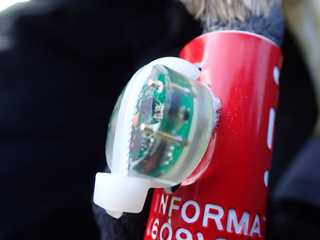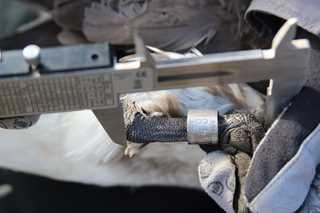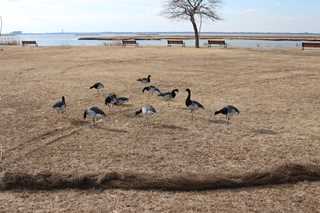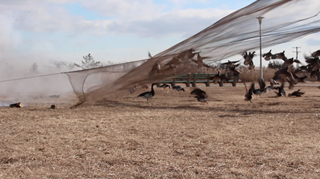Atlantic Brant Telemetry Project
Researchers are using technology to learn more about this unique species
Researchers are using technology to learn more about this unique species
By Joseph Albanese
Atlantic Brant populations have fluctuated for many years. A peak in 2008 allowed the U.S. Fish and Wildlife Service (USFWS) to instate a temporary three-bird bag limit, but continued fluctuations brought the bag limit back to two birds in the years that followed. This pales in comparison to the years of yore, where brant populations could support limits as high as 25 birds per hunter. Since the 200809 hunting season, brant numbers have been on a moderate decline. Current estimates place the number of Atlantic brant around 200,000.

A task force consisting of the New Jersey Division of Fish and Wildlife, New York State Department of Environmental Conservation, and Canadian Wildlife Service is now attempting to determine nesting success using high-tech methodology. To identify migration routes and timing, ascertain staging areas, clarify breeding-range boundaries, and find previously unknown breeding colonies, the researchers are equipping several individual brant with GPS transmitters, which resemble tiny backpacks. The effort began after the close of the 201718 waterfowl hunting season. Teams in New York and New Jersey placed approximately 10 transmitters and 75 geolocators each and aim to do so again after the end of this hunting season. The Canadian Wildlife Service put roughly 40 transmitters and 400 geolocators on birds they captured on the nesting grounds this summer and will try to replicate this feat next year.

Branta bernicula hrota, commonly known as Atlantic brant, shares a genus with the more numerous Canada goose, but has distinctly different habits and utilizes different habitats, though there is some overlap between the two. Brant are the smallest members of the goose family, weighing in at about three pounds, about as much as a corn-fattened mallard. Instead of the characteristic white cheek of the Canada, brant have white bars that form a necklace. The prominence of this feature is used by the females to judge the suitability of a mate, much like antlers on a white-tailed deer. Brant take three years to reach sexual maturity; the age of an individual can be determined by the presence or absence of the white necklace and markings on the wings. A hatch-year bird will have no necklace but will feature prominent bars on the wings, a first-year individual will have the beginnings of a necklace and faded wing bars, and adults will have a well-defined necklace and no wing bars.

In 2014 and 2015, a team of researchers from the University of Delaware, led by Professor of Wildlife Ecology Chris Williams, made the long, arduous journey to Southampton Island in the Canadian Arctic Archipelago to assess the challenges these long-distance migrators face when they nest. The team conducted their research on a site that was first studied in 1979, giving them 35 years of data to compare. In 1979, 455 Atlantic brant nests were present. In 2014, there were 44, only two of which were successful. Additionally, the number of cackling and snow geese nesting in the region had increased significantly.
There were many egg predators present on Southampton Island as well, including gulls, parasitic jaegers, and polar bears, but arctic foxes are responsible for most brant nest losses. Williams calls attention to the birds preference to nest on islands surrounded by the protection that deep water affords. The team measured water depths around the nests in the study area and found that fox depredation dropped off substantially once water depth exceeded 20 centimeters, which is approximately neck-high on the arctic fox. With snows melting sooner than in previous years, earlier-arriving cackling and snow geese can take advantage of these prime deep-water sites before brant even arrive, forcing them to nest on sites more prone to fox depredation.

The transmitters placed on the birds record latitude and longitude every three hours as long as the sun is shining. Every three days they will automatically upload their data, and researchers will receive a spreadsheet of the birds movements. Because of the weight of these units, they were placed only on larger male brant that weighed more than 1,450 grams, or about 3.2 pounds. The GPS transmitters will provide valuable insight into the birds 1,000-plus-mile migration, but scientists hope they can combine the GPS data with information collected by a different logger to determine nesting success remotely.

Originally developed by the British Antarctic Survey, geolocators use a parietal, or light-sensing, eye to record photoperiod. These minute devices are used to track travel over long distances in applications where the apparatus has a clear view of natural light levels at dawn and dusk, which can be compared with a calendar to give approximate latitude. Weighing much less than most transmitters, geolocators have been invaluable in gathering information on lighter birds such as terns, skuas, and other seabirds that are too small to transport GPS devices. The Achilles heel of these devices is that they must be retrieved for data download, requiring that the bird be recaptured.

The use of geolocators on brant is a novel expansion of their traditional role, as they will be used to estimate time on a nest. To this end, these devices were placed mostly on females, though a few were placed on males also equipped with transmitters to verify the accuracy of the geolocators. Being in the Arctic with nearly endless daylight, any dark period can be associated with the locators view of the sky being obstructed by the brants body as it sits on the nest. If that time period doesnt correspond with the birds average incubation period of 2226 days, it can be assumed that the nesting attempt has failed.





There are few things as exciting to a waterfowler as harvesting a banded bird. Hunters pursuing Atlantic brant may run into some birds wearing more than the typical metal band this fall and participate in some interesting science in the process. If you are fortunate enough to harvest an Atlantic brant so adorned, please make arrangements to return the transmitters or geolocators by calling the phone number imprinted on them. Once the data is downloaded, researchers will return the geolocator to you. In the case of transmitters, a dummy unit will be provided so that you can place it on a mount or display it in whatever manner you choose.
Ducks Unlimited uses cookies to enhance your browsing experience, optimize site functionality, analyze traffic, and deliver personalized advertising through third parties. By continuing to use this site, you agree to our use of cookies. View Privacy Policy